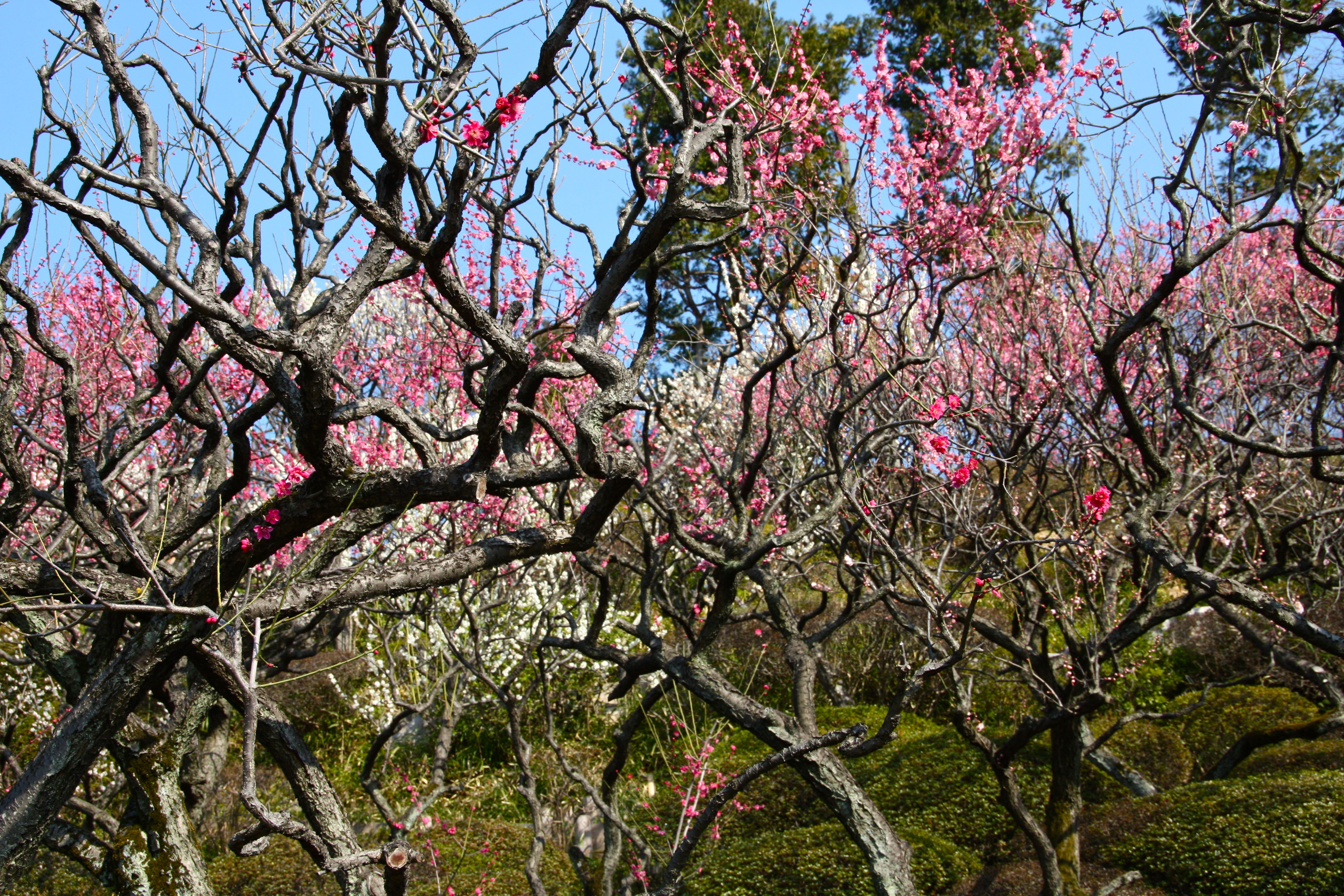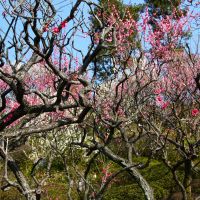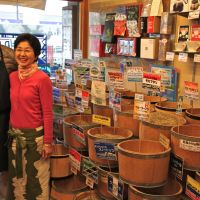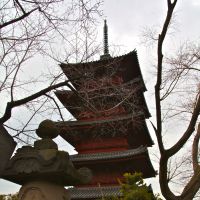Whether you call the Prunus mume a plum or an apricot (it is related to both), the flowers are plum elegant on their leafless, shiny branches and help cheer us through winter's finale. To enjoy them to the full, I seek out Ikegami Baien Garden in southern Tokyo's Ota Ward, having hopped the Tokyu Ikegami Line to Ikegami Station and taken the only exit.
I follow signs to Ikegami's other claim to fame, Honmonji Temple, one of Japan's seminal Nichiren sites. A revolutionary monk, Nichiren (1222-82) was repeatedly exiled and persecuted for his staunch opposition to the dominant Buddhist doctrines of his day, and at age 61 his health was failing.
En route to hot springs in present-day Ibaraki Prefecture for relief, he stopped to visit a disciple, the feudal lord Munenaka Ikegami, for whom this area was named. While there, however, Nichiren died — but not before sanctioning the establishment of a temple on Ikegami's land.
Ikegami duly fulfilled Nichiren's wish, and built the temple on a 69,384-tsubo plot (about 230,000 sq. meters) — one tsubo for each Chinese character in the "Lotus Sutra" the monk considered the core of Buddhist instruction.
The road to Honmonji is flanked with sweet shops that distract me from pondering Nichiren's belief that enlightenment can be achieved in a single lifetime. I pass several shops selling kuzumochi, a traditional confection concocted from arrowroot starch and water, and topped with kinako (sweetened soybean flour) and kuromitsu (brown-sugar syrup). Perhaps before enlightenment comes enlargement ...
Disliking that idea, I stop at Asanoya, purveyor of tokoroten noodles and anmitsu cubes, both made from a fiber-rich, zero-calorie agar. I judge them a healthier choice. "They're not, if you add bean paste or pour on kuromitsu," notes Masahiro Asano, one of the 12th generation in his family to run Asanoya. "But they're such fun to eat."
In front of the shop, I poke what looks like a rolled bale of golden hay in a clear bag. It's sinewy and slightly pliable. "That's tengusa, the seaweed we use to make the agar," Masahiro says, sending me off on a 10-minute stroll to watch the process in Asanoya's kitchen.
There, his mother lets me into the spotless facility where Masahiro's younger brother, Koji, 36, is busy trimming the dross from long opalescent bricks of agar. Next, he slips a brick into a tsukidashi (a tool for pressing the gel into either noodles or cubes). As he works, he explains how the bricks are made — which just seems to involve boiling the seaweed in water for about an hour, then straining and molding what's left. If it's that simple, I wonder aloud, how has the Asano family kept its business going through 12 generations?
"Because we've had to," Koji laughs — then attributes Asanoya's current success to the family's 70-year-old akado gama (a rare red-copper boiling pot), and to their superior tengusa from Miyakejima Island. As Koji presses the jelly brick into neat cubes, I am allowed to try one diaphanous morsel. Unlike any gelatin I've ever tried, it carries a faint ocean tang, which I think might mingle nicely with kuromitsu.
On the temple road again, I find Kikuya, a store selling what look like paper party crackers. "These are souvenir models of matoi, the standards on poles carried by firefighters in Edo (present-day Tokyo)," explains Hisako Ishiwata, 71. "Each neighborhood used to have its own distinct design," she says.
Ishiwata explains that real matoi are about 2.4 meters high, weigh 20 kg, and these days only come out for a spin during festivals and parades. Honmonji's annual Oeshiki Festival on Oct. 12, the anniversary eve of Nichiren's death, is a great place to see them in action, she suggests, showing me one of her handmade miniatures of the local matoi design.
Thanking Ishiwata, I mosey off, passing storefronts with a distinct 1950s feel to them. The only standout, in fact, is a former teahouse dating from 1876 that is now occupied by the Yorozuya Sake Shop. A hand-pump well outside, and the graceful lines of its stacked roofs, help me imagine how the whole area must have looked in the decades after 1868's Meiji Restoration.
Turning left at Yorozuya, I glimpse the flight of 96 steps leading up to Honmonji. Guessing there's no lunch up top, I pop into Chitoseya, a bustling soba shop. There, the Nakajimas, both in their late 70s, are busy but friendly. After I order a Seven Lucky Gods Soba, they shout out their story in snippets, and Reiko points at a woodblock print featuring Chitoseya in the mid-1700s. "We were a ryōtei (inn) then," she tells me.
When my soba arrives, I'm thrilled to find it stuffed with goodies, including baby shrimp, veggies and tempura fancied up with something. "That's real gold leaf. It's good for your health," Reiko's husband calls out from across the store as she ushers in a new group of customers.
Gold-plated, satiated and paid up, I finally scale the 96 steps of Shikyo Nanji-zaka (Difficulty-of-maintaining-faith Slope) to Honmonji. At the top, Honmonji's relatively new temple buildings — the old ones were destroyed in World War II — gleam on their elevated plateau. The weather is too inviting to go inside, so I stroll under budding cherry trees and meet the stern gaze of a 1-ton aluminum statue of Nichiren designed by Seibo Kitamura (1884-1987) and erected here in 1983.
I zigzag through ancient tombs to find Honmonji's carnelian-colored Gojyu-no-to (Five-storied Pagoda), an elegant survivor of wars, typhoons, fires and earthquakes since 1608. Standing 29.4 meters, and puzzled together in the elaborate Momoyama style, the pagoda is the oldest in the Kanto region.
Exploring further, I locate a somber, moat-encircled tomb known as Manryotsuka that was built in 1708 for Hoshouin — nicknamed "Chacha-hime" — a granddaughter of Ieyasu Tokugawa, founder of the Tokugawa Shogunate (1603-1867). The grave was recently reconstructed, and in the process excavations unearthed holes dug for pit houses believed to date from the Yayoi Period (300 B.C. to A.D. 300) and remains of dwellings subsequently on the site until around 550. Well, of course. Who wouldn't want to live on this lovely quiet promontory, isolated from the world below?
But I must return to that more earthly plane. So, on I jog down the 96 steps, before veering right onto a road monopolized by gravestone workshops. Koichiro Miyauchi, 73, has masked over a grave marker leaving only the characters to be engraved into it cut out of the stencil ready for sand-blasting. As he deftly perfects the characters with a craft scalpel, sunshine ironically paints the shadow of a cross on his cap.
I want to stop and chat, but Miyauchi is shy, and grave, so I pass on. Climbing a flight of stairs, I discover — alone in a grove and brilliant as a tomato in a salad — the recently restored 1830 Hoto Tower, commemorating Nichiren's cremation site.
Nearby, Daibyo Hongyoji Temple, built in 1282 where Ikegami's residence had been, is the site where Nichiren died. In fact a hall directly over the room where the monk spent his last days displays a section of the pillar he was supposed to have leaned upon while preaching during his final hours. Worshippers have stroked it to a silky finish.
Meanwhile, a cherry tree just outside the hall is said to have bloomed out of season, in October, when Nichiren died. Three or four blossoms are out now, so it must have regained its natural rhythm.
Regaining mine, and guided by a heady fragrance, I find Ikegami Baien. Paying the garden's ¥100 entrance fee, I gaze on 9,880 sq. meters of woodland — wherein many of the 30 varieties of Prunus mume are on the verge of being in full bloom. Set against rich-green azalea bushes, revealed on winding paths and glorious against the backdrop of teahouses, the garden's 150 white-flowering plums and 220 cinnamon-scented red- and pink-flowering varieties are breathtaking.
The first teahouse I pass was the prewar atelier of Japanese print artist Shinsui Ito, known for his bijinga (prints of beautiful women). In front of a second teahouse, I find a suikinkutsu, an ingenious natural musical instrument "played" by water dripping through rocks into a concealed container underground. The sound of water drops, like harp strings, is here magnified by mystery — and by placing one's ear on a hollow bamboo pole to listen.
I hate to leave the garden, but a banner outside had informed me that it will be used as a location in national broadcaster NHK's upcoming asadora (morning television drama series) "Ume-chan Sensei" ("Peach-boy Teacher"), premiering April 2.
The weather grays as I head back toward Ikegami Station. I pause at Iitomo Honten, a shop specializing in all things made from sesame seeds, sampling a dangerously addictive sesame-and-salt candy. Then, following a divine aroma, I locate Roasting Cafe, and stop in for a cup.
"This isn't a cafe," owner Haruyoshi Onuma, 56, informs me. I look at the table and chairs, the beans, the cups and then Onuma. "You buy beans, and while we roast them to order, you get free coffee," he explains. I plunk down for beans, and as the roasting machine settles into a maracas rhythm, Onuma ceremoniously brews me a cup. He and his wife, Setsuko, beam as — at the end of the day — I feel slightly enlightened.






